Excerpts from Jim Conrad's
Naturalist Newsletter
from the November 16, 2018 Newsletter issued from Rancho Regenesis in the woods ±4kms west of Ek Balam Ruins; elevation ~40m (~130 ft), N20.876°, W88.170°; north-central Yucatán, MÉXICO
PICRAMNIA!
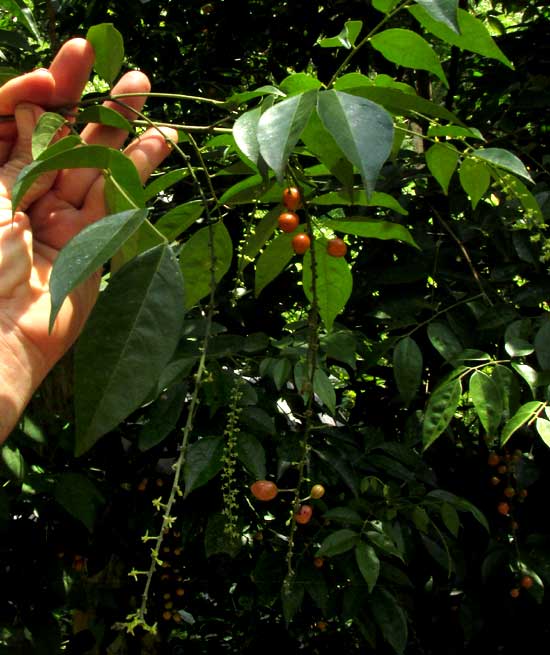
The "!" after the name Picramnia points to the fact that I've been "doing the botany" on this plant for the last four months or so but only this week did I figure out what it was. Last June during the early rainy season this plant -- a shrub or small tree about ten ft tall (3m) -- was both flowering and fruiting, as seen above
The leaves, which alternated with one another along the stem, were pinnately compound with seven or so leaflets, shown at below:
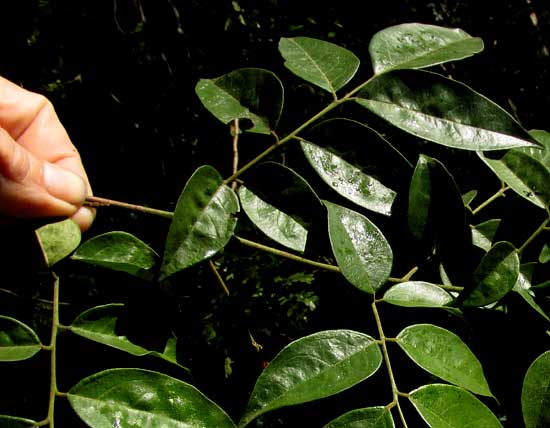
Young stems and leaf petioles were densely short-hairy, or velvety, as illustrated below:

Flowers were arranged in long, drooping racemes longer than the leaves, as seen below:
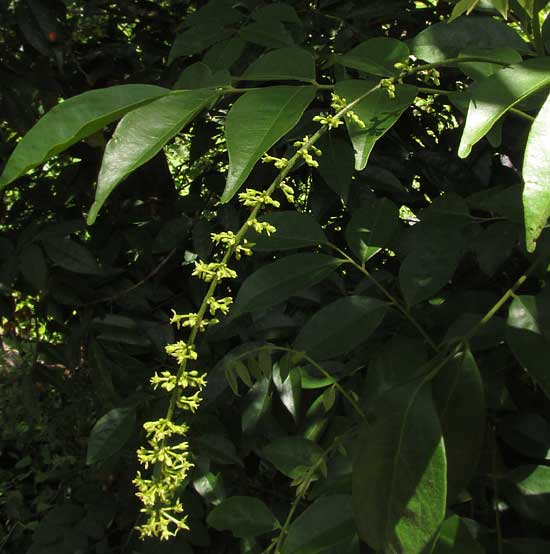
Up close, all the flowers proved to be unisexual females -- so plants in this species are "dioecious." There must have been a male in the neighborhood but I never found him. The simple, elegant structure of a female flower seen from the side can be admired below:

The green, hairy, spherical item in the picture's center is the ovary, atop which two curving, pollen-receiving stigmas arise. The scoop-shaped, whitish items below the ovary are petals, and between each petal's base and the ovary's base is a nectar-producing gland. Looking at the flower from above, you see that it bears three whitish petals below which three greenish sepals arise.
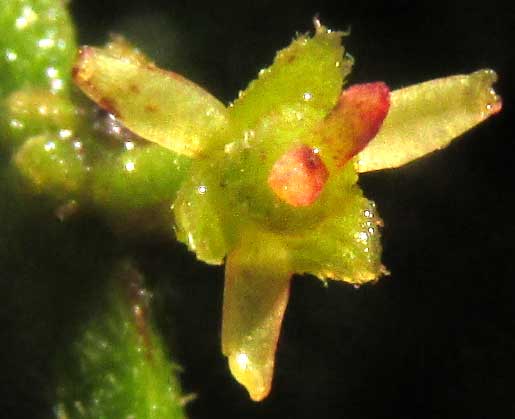
These are great field marks and at this point I was certain that already I should be able to identify it: The above features indicated the Quassia Family, the Simarubaceae. The problem was that our plant didn't match any of the species in that family listed as occurring in the Yucatan. Returning to the little tree, a cross section of the ovary was taken, revealing what's shown below:
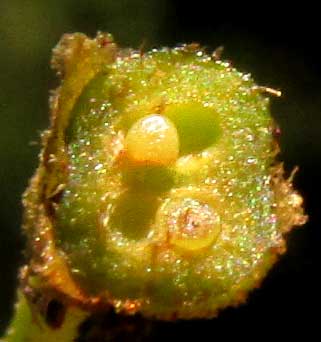
The ovary is divided into two compartments, or "carpels," with two ovules per carpel. In the picture, in both carpels one ovule has been removed while another, or part of one, remains.
Ovaries with ovules mature into fruits with seeds, and our little tree bore flowers, fruits in all stages, including green ones, almost-mature orangish ones, and blackish ripe fruits, as shown below:
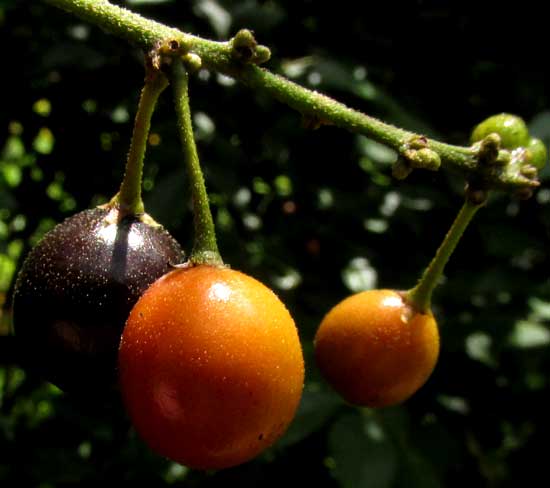
Cross-sections of maturing fruits showed one or two seeds developing inside, as shown below:
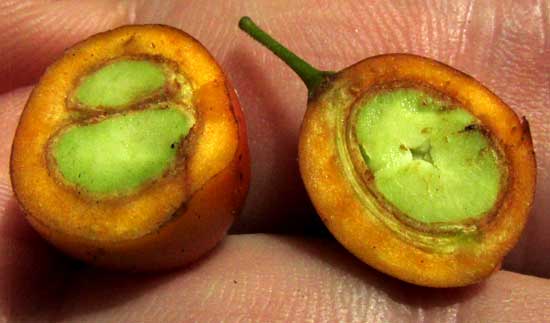
In that picture the section shown on the right is taken lengthwise, not across. The cross section shows that of the four ovules the ovary began with, only one is developing into a robust seed, a second is limited in its growth, and apparently the other two have aborted.
With all these details at hand, the identification should have been easygoing. However, all the literature sent me back to the Quassia Family, the Simarubaceae. The only species in that family often known by northerners is the Tree-of-Heaven, or Ailanthus. If you're familiar with that native Chinese tree, often planted and escaped in much of the US, you've smelled its sharp, musky odor. Our little Yucatan tree's crushed odor produced a similarly sharp smell, seeming to support the Quassia Family ID.
The problem was, that since my sources were published, some genera in the Quassia Family have been separated into newly formed families, and our little Yucatan tree was one of them. It's now placed in the Picramnia Family, the Picramniaceae. Not only that, but the Picramnia Family was given it own new order, the Picramniales.
To put that into perspective, in bird classification, all songbirds, from stubby House Sparrows to sleek warblers and vireos, belong to the Passerine Order. Being put into your own order indicates that your ancestors evolved something special not shared with closely related orders. The reason given for separating the Picramnia Family is that members of the Quassia Family to which it used to belong are supposed to have only one ovule per ovary carpel, while we've seen that our tree's ovaries have two.
So, what species of the genus Picramnia do we have? Two species are listed for the Yucatan Peninsuala: Picramnia antidesma and Picramnia teapensis. They are similar to one another and not many details are given about them on the Internet. In the Yucatan Picramnia antidesma frequently has been collected on the peninsula's eastern side, maybe within 75 miles of the Caribbean coast -- in the rainier parts. Collections aren't mentioned from here in the central area. However, a few collections of Picramnia teapensis have been made in the more arid interior.
Also, leaves of Picramnia antidesma are described as "subcoriaceous," meaning somewhat leathery, while Picramnia teapensis leaves are "membranaceous," or of the texture of parchment. Ours are more membranaceous, so that's a second vote for Picramnia teapensis.
A dried herbarium sheet of Picramnia teapensis on the Internet shows hairy young twigs and petioles like ours, so on these grounds alone I'm thinking we have Picramnia teapensis with about 80% certainty.
Picramnia teapensis occurs from southern Mexico south through Central America into northern South America. The genus Picramnia, restricted to the American tropics, is represented by 41 species, which mostly inhabit rainforests. Our species is among the few adapted to more arid conditions.
And here's one final detail, which surely has no significance at all, but which is weird. This Picramnia teapensis and the Bonellia bush profiled in September, belong to the two smallest, most obscure plant families of I've found in this area -- the Picramnia and Theophrastus Familes. I've found only one plant of each. Yet these two trees were standing so close together that their limbs were intertwined. The habitat was similar to what's seen for miles around. It's almost too much of a coincidence.